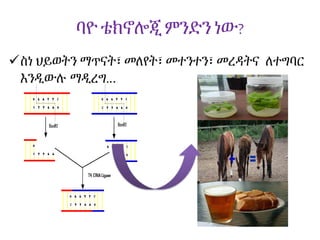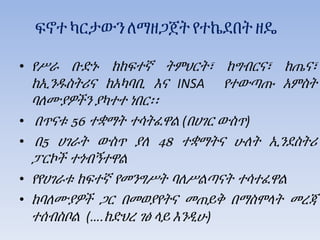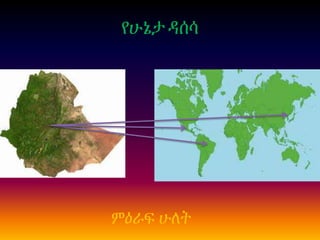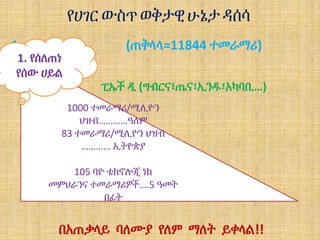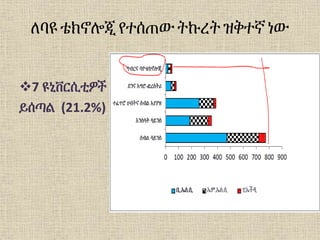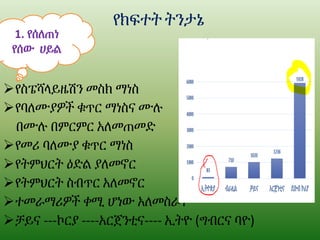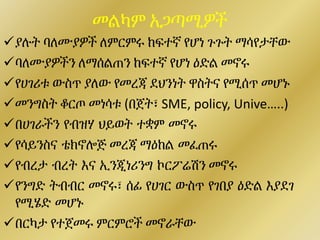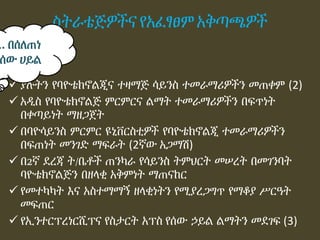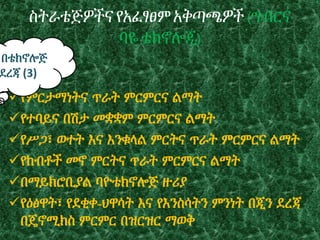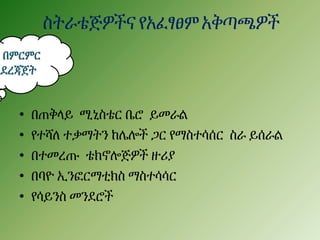Ethiopian Biotechnology Road Map
- 1. ßŗ©ßŖóßēĄßŗ«ßīĄßŗ½ ßŗ©ßēŻßŗ« ßē┤ßŖŁßŖ¢ßłÄßīģ ßłØßłŁßłØßłŁßŖō ßłŹßłøßēĄ ߏŹßŖ¢ßē░ ßŖ½ßłŁßē│ ßł©ßēéßēģ ßł░ßŖÉßŗĄ ßłśßīŗßēóßēĄ/2007 ßŖĀßēģßł½ßēó: ßŖĀßēŻßŗŁßł░ßŗŹ ßŖĀßŗ©ßłł
- 2. ßłøßŗŹßī½ ’ā╝ ßłśßīŹßēóßŗ½ ’ā╝ ߏŹßŖ¢ßē░ ßŖ½ßłŁßē│ßŗŹßŖĢ ßłłßłøßŗśßīŗßīĆßēĄ ßŗ©ßē░ßŖ¼ßŗ░ßēĀßēĄ ßŗśßŗ┤ ’ā╝ ßŗ©ßłĆßīłßłŁ ßŗŹßłĄßīź ßłüßŖößē│ ßŗ│ßł░ßł│ ’ā╝ ßŗ©ßŗŹßīŁ ßłĆßīłßłŁ ßłüßŖößē│ßŗ│ßł░ßł│ ’ā╝ ßŗ©ßŖŁßŹŹßē░ßēĄ ßēĄßŖĢßē│ßŖö ’ā╝ ßē░ßīŹßŗ│ßł«ßēČßēĮßŖō ßłśßłŹßŖ½ßłØßŖĀßīŗßīŻßłÜßŗÄßēĮ ’ā╝ ßłĄßēĄßł½ßē┤ßīģßŗÄßēĮßŖō ßŗ©ßŖĀߏłßŹāߏĆßłØ ßŖĀßēģßīŻßī½ßŗÄßēĮ ’ā╝ ßłøßīĀßēāßłŹßŗ½
- 4. ßŗ©ßŹŹßŖ¢ßē░ßŖ½ßłŁßē│ßŗŹßŖĀßłŗßłø ’āś ßłĆßīłßł½ßŗŖßŗŹ ßŗ©ßēŻßŗ«ßē┤ßŖŁßŖ¢ßłŹßīé ßŗ©ßŗĢßŗĄßīłßēĄ ßŗ░ßł©ßīā ßŖĀßłüßŖĢ ßŗ½ßłłßēĀßēĄßŖĢ ßēĀßŗØßłŁßŗØßłŁ ßłøßŗłßēģ ’āś ßŖĀßłłßłØ-ßŖĀßēĆߏł ßŗ©ßēŻßŗ«ßē┤ßŖŁßŖ¢ßłŹßīé ßŗ©ßŗĢßŗĄßīłßēĄ ßŗ░ßł©ßīāßŖĢ ßŖĀßīźßŖĢßēČ ßēżßŖĢßēĮßłøßłŁßŖŁ ßłøßŗĄßł©ßīŹ ’āś ßŖ©ßŖŁßŹŹßē░ßēĄ ßēĄßŖĢßē│ßŖößŗŹ ßē░ßŖÉßłĄßēČ ßēĀßē│ßŗłßēüßēĄ ßŗ©ßŗĢßŗĄßīłßēĄßŖō ßēĄßł½ßŖĢßłĄßŹŹßłŁßł£ßłĮßŖĢ ßŗĢßēģßŗĄ ßŗśßłśßŖōßēĄ ßŗŹßłĄßīźßłĄßēĄßł½ßē┤ßīéßŖ½ßŗŖ ßłśßŗ│ßł©ßł╗ ßłøßłĄßēĆßłśßīź
- 5. ßēŻßŗ« ßē┤ßŖŁßŖ¢ßłÄßīéßłØßŖĢßŗĄßŖĢßŖÉßŗŹ? ’ā╝ßłĄßŖÉ ßłģßŗŁßŗłßēĄßŖĢ ßłøßīźßŖōßēĄßŹŻ ßłśßłłßŗ©ßēĄßŹŻ ßłśßē░ßŖĢßē░ßŖĢߏŻ ßłśßł©ßŗ│ßēĄßŖō ßłłßē░ßīŹßēŻßłŁ ßŖźßŖĢßŗ▓ßŗŹßłē ßłøßŗ▓ßł©ßīŹ...
- 6. ßŗ©ßēŻßŗ« ßē┤ßŖŁßŖ¢ßłÄßīé ßŗśßłŁßŹÄßēĮ 1. ßłģßŖŁßłØßŖō ßēŻßŗ« ßē┤ßŖŁßŖ¢ßłÄßīé 2. ßīŹßēźßłŁßŖō ßēŻßŗ« ßē┤ßŖŁßŖ¢ßłÄßīé 3. ßŖóßŖĢßŗ▒ßłĄßēĄßł¬ ßēŻßŗ« ßē┤ßŖŁßŖ¢ßłÄßīé 4. ßŖĀßŖ½ßēŻßēó ßēŻßŗ« ßē┤ßŖŁßŖ¢ßłÄßīé
- 7. ßŗ©ßēŻßŗ«ßē┤ßŖŁßŖ¢ßłŹßīģ ßłŹßłøßēĄ ßłłßŖóßēĄßŗ«ßīĄßŗ½ ßŖĀßłĄßŹłßłŗßīŖßŖÉßē▒ ŌĆó ßŗ©ßēźßŗØßłĆ ßłģßŗŁßŗłßēĄ ßłĆßēźßēĄ ßŖ©ßŹŹßē░ßŖø ßłśßłåßŖæ ŌĆó ßŗ©ßēĆßŖĢßŗĄ ßŖ©ßēźßēĄ ßłĆßēźßēĄ ßŖŁßłØßēĮßēĄ ŌĆó ßēĀߏŹßīźßŖÉßēĄ ßŖźßŗ©ßī©ßłśßł© ßŗ©ßłśßīŻßŗŹ ßŗ©ßłģßŗØßēź ßēźßŗøßēĄ ŌĆó ßŗ©ßłØßīŹßēź ßīźßł½ßēĄßŖō ßŗ©ßīżßŖō ßłĮߏŗßŖĢ ŌĆó ßŗ©ßłśßŗĄßŖĆßŖÆßēĄ ßēģßłśßłø ŌĆó ßŗ©ßŖóßŖĢßŗ▒ßłĄßēĄßł¬ ßīŹßēźßŗōßēČßēĮ ßŖ©ßŗŹßīŁ ßłĆßīłßłŁ ßłĄßłłßłÜßīłßēĪ
- 8. ߏŹßŖ¢ßē░ ßŖ½ßłŁßē│ßŗŹßŖĢ ßłłßłøßŗśßīŗßīĆßēĄ ßŗ©ßē░ßŖ¼ßŗ░ßēĀßēĄ ßŗśßŗ┤ ŌĆó ßŗ©ßłźßł½ ßēĪßŗĄßŖæ ßŖ©ßŖ©ßŹŹßē░ßŖø ßēĄßłØßłģßłŁßēĄßŹŻ ßŖ©ßīŹßēźßłŁßŖōߏŻ ßŖ©ßīżßŖōߏŻ ßŖ©ßŖóßŖĢßŗ▒ßłĄßēĄßł¬ßŖō ßŖ©ßŖĀßŖ½ßēŻßēó ßŖźßŖō INSA ßŗ©ßē░ßŗŹßīŻßīĪ ßŖĀßłØßłĄßēĄ ßēŻßłłßłÖßŗ½ßŗÄßēĮßŖĢ ßŗ½ßŖ½ßē░ßē░ ßŖÉßēĀßłŁßŹĪߏĪ ŌĆó ßēĀßīźßŖōßē▒ 56 ßē░ßēŗßłøßēĄ ßē░ßł│ßēĄßŹłßŗŗßłŹ (ßēĀßłĆßīłßłŁ ßŗŹßłĄßīź) ŌĆó ßēĀ5 ßłĆßīłßł½ßēĄ ßŗŹßłĄßīź ßŗ½ßłł 48 ßē░ßēŗßłøßēĄßŖō ßłüßłłßēĄ ßŖóßŖĢßŗ░ßłĄßēĄßł¬ ߏōßłŁßŖ«ßēĮ ßē░ßīÄßēźßŖØßē░ßŗŗßłŹ ŌĆó ßŗ©ßŗ©ßłĆßīłßł½ßē▒ ßŖ©ßŹŹßē░ßŖø ßŗ©ßłśßŖĢßīŹßłźßēĄ ßēŻßłłßłźßłŹßīŻßŖōßēĄ ßē░ßł│ßē░ߏłßŗŗßłŹ ŌĆó ßŖ©ßēŻßłłßłÖßŗ½ßŗÄßēĮ ßīŗßłŁ ßēĀßłśßŗłßŗ½ßŗ©ßēĄßŖō ßłśßīĀßŗŁßēģ ßēĀßłøßłĄßł×ßłŗßēĄ ßłśßł©ßīā ßē░ßł░ßēźßłĄßē”ßłŹ (ŌĆ”.ßŖ©ßŗĄßłģßł© ßīłßŹģ ßłŗßŗŁ ßŖźßŖĢßŗ▓ßłü)
- 10. ßŗ©ßłĆßīłßłŁ ßŗŹßłĄßīźßŗłßēģßē│ßŗŖ ßłüßŖößē│ßŗ│ßł░ßł│ 1. (ßīĀßēģßłŗßłŗ=11844 ßē░ßłśßł½ßłøßł¬) ߏÆßŖżßēĮ ßŗ▓ (ßīŹßēźßłŁßŖōߏŻßīżßŖōߏŻßŖóßŖĢßŗ▒ߏŻßŖĀßŖ½ßēŻßēóŌĆ”) ßēĀßŖĀßīĀßēāßłŗßŗŁ ßēŻßłłßłÖßŗ½ ßŗ©ßłłßłØ ßłøßłłßēĄ ßŗŁßēĆßłŗßłŹ!! 1000 ßē░ßłśßł½ßłøßł¬/ßłÜßłŖßŗ«ßŖĢ ßłģßŗØßēźŌĆ”ŌĆ”ŌĆ”ŌĆ”ßŗōßłłßłØ 83 ßē░ßłśßł½ßłøßł¬/ßłÜßłŖßŗ«ßŖĢ ßłģßŗØßēź ŌĆ”ŌĆ”ŌĆ”ŌĆ” ßŖóßēĄßŗ«ßīĄßŗ½ 105 ßēŻßŗ« ßē┤ßŖŁßŖ¢ßłÄßīé ßŖÉßŖŁ ßłśßłØßłģßł½ßŖĢßŖō ßē░ßłśßł½ßłøßł¬ßŗÄßēĮŌĆ”.5 ßŗōßłśßēĄ ßēĀߏŖßēĄ 1. ßŗ©ßł░ßłłßīĀßŖÉ ßŗ©ßł░ßŗŹ ßłĆßŗŁßłŹ
- 11. ßłłßēŻßŗ® ßē┤ßŖŁßŖ¢ßłÄßīé ßŗ©ßē░ßł░ßīĀßŗŹ ßēĄßŖ®ßł©ßēĄßŗØßēģßē░ßŖø ßŖÉßŗŹ ’üČ7 ßŗ®ßŖÆßē©ßłŁßł▓ßē▓ßŗÄßēĮ ßŗŁßł░ßīŻßłŹ (21.2%)
- 12. ßŗ©ßłĆßīłßłŁ ßŗŹßłĄßīź ßŗłßēģßē│ßŗŖßłüßŖößē│ ßŗ│ßł░ßł│ ’āśßēĀßēé ßŗ©ßłåßŖÉ ßłŗßēźßł½ßēČßł¬ßŖō ßłśßł│ßł¬ßŗ½ ßŗ©ßłłßłØ ’āśßŗ½ßłēßēĄßłØ ßŖĀßł«ßīīßŖō ßīźßīłßŖō ßŗ©ßłÜßł╣ ßŖōßēĖßŗŹ ’āśßŖ¼ßłÜßŖ½ßłÄßēĮ ßēĀßēĆßłŗßłē ßłøßīŹßŖśßēĄ ßŖĀßŗŁßē╗ßłŹßłØ ’āśßŗ©ßēĀßīĆßēĄ ßŖĀßēģßłŁßē”ßēĄ ßŖĀßŖÉßłĄßē░ßŖø ßŖÉßŗŹ 2. ßēĀßłØßłŁßłØßłŁ ßłśßł░ßł©ßē░ ßłŹßłøßēĄ
- 13. ßŗ©ßłĆßīłßłŁ ßŗŹßłĄßīź ßŗłßēģßē│ßŗŖßłüßŖößē│ ßŗ│ßł░ßł│ ’ā╝ßēĀßŖĀßł½ßē▒ßłØ ßŗśßłŁßŹŹ ßŗ½ßłłßŗŹ ßłāßłŗ ßēĆßłŁ ßŗ©ßłÜßēŻßłŹ ßŖÉßŗŹ ’ā╝ßēĀßīŹßēźßłŁßŖōßŗŹ ßŗśßłŁßŹŹ ßŗ½ßłłßŗŹ ßŗśßłŹ ßłśßŗ│ßŗŖ ßē┤ßŖŁßŖ¢ßłÄßīé ßŖÉßŗŹ ’ā╝ßēĀßłśßŗĄßłĆßŖÆßēĄ ßēģßłśßłø ßłŗßŗŁ ßŗłßŗ░ ßłāßłŗ ßē░ßēĆßłŁßē░ßłŹ (90/300) 2006 =800 ßłÜßłŖßŗ«ßŖĢ ßŗČßłŗßłŁ 3. ßēĀßē┤ßŖŁßŖ¢ßłÄßīé ßŗ░ßł©ßīā
- 14. ßŗ©ßłĆßīłßłŁ ßŗŹßłĄßīź ßŗłßēģßē│ßŗŖßłüßŖößē│ ßŗ│ßł░ßł│ ’ā╝ßŗ©ßē░ßīĆßłśßł®ßēĄ ßłØßłŁßłØßł«ßēĮ ßēĀßŗ© ßē”ßē│ßŗŹ ßŗ©ßē░ßēĀßē│ßē░ßŖæ ßŖōßēĖßŗŹ ’ā╝ßŗ©ßŗ│ßēĀßł© ßŖóßŖĢßē©ßłĄßēĄßłśßŖĢßēĄ ßŗ©ßłłßłØ ’ā╝ßŖźßłŁßłĄ ßēĀßŖźßłŁßłĄ ßŖĀßłłßłśßŖōßēĀßēź 4. ßēĀßłØßłŁßłØßłŁ ßŖĀßŗ░ßł©ßīāßīĆßēĄ
- 15. ßŗ©ßŗŹßīŁ ßłĆßīłßłŁ ßłüßŖößē│ßŗ│ßł░ßł│ ’āśßēĀßēźßł½ßŗÜßłŹ ßēģßŗĄßłÜßŗ½ ßēĀßē░ßł░ßīŻßēĖßŗŹ ßłśßłĄßŖ«ßēĮ ßł░ßŗÄßēĮßŖĢ ßŗłßŗ░ ßŗŹßī¬ ßłŹßŖ« ßłøßł░ßłŹßīĀßŖĢߏŻ ’āśßŖ«ßł¬ßŗ½ ßīĀßŖĢßŖ½ßł½ßŖō ßŖĀßłłßłØ ßŖĀßēĆߏŹ ßŖźßŗŹßēģßŖō ßŗ½ßłŗßēĖßŗŹ ßŗ©ßŖ©ßŹŹßē░ßŖø ßēĄßłØßłģßłŁßēĄ ßē░ßēŗßłøßēĄßŖĢ ßłśßŖ¢ßłŁ ’āśßŗ©ßŖĀßłŁßīĆßŖĢßē▓ßŖō ßēĀßłØßłŁßēĄ ßłØßłŁßłØßłŁ ßłŗßŗŁ ßŗ©ßē░ßłĀßłøßł® ßēŻßłłßłÖßŗ½ßŗÄßēĮßŖĢ ßŖ©ßŹŹßē░ßŖø ßłśßłåßŖæ 1. ßēĀßł░ßŗŹ ßłĆßŗŁßłŹ
- 16. ßŗ©ßŗŹßīŁ ßłĆßīłßłŁ ßłüßŖößē│ ßŗ│ßł░ßł│ ŌĆó ßēźßł½ßŗÜßłŹ ßē░ßł×ßŖŁßł« ßŗ©ßłÜßŗ½ßł│ßŗ©ßŗŹ ßłśßŖĢßīŹßłźßēĄ ßēĀßŖ©ßŹŹßē░ßŖø ßēüßłŁßīĀßŖØßŖÉßēĄ ßłłßłØßīŹßēź ßŗŗßłĄßēĄßŖōߏŻ ßŖóßŖĢßŗ▒ßłĄßēĄßł¬ŌĆ”ßŗ©ßē░ßŖÉßł│ ßŖÉßŗŹ ŌĆó ßŖ«ßłŁßŗ½ (ßēŻßŗ« ßŖóßŖĢߏÄßłŁßłøßē▓ßŖŁßłĄßŹŻ ßīģßŖ¢ßłÜßŖŁßłĄŌĆ”.) ŌĆó ßē╗ßŗŁßŖō (3-ßŗĄ ,personal medcine, simulation software) 2. ßēĀßłśßł░ßł©ßē░ ßłŹßłøßēĄ
- 17. ßŗ©ßŗŹßīŁ ßłĆßīłßłŁ ßłüßŖößē│ ßŗ│ßł░ßł│ ’üČßŖ®ßēŻ ßēĀßŖĀßŖ½ßēŻßēó ßēŻßŗ« ßē┤ßŖŁßŖ¢ßłÄßīéßŖō ßēĀßŖĀßłłßłØ ßŗ©ßīłßēĀßŗ½ ߏŹßłŗßīÄßēĄ ’üČßēźßł½ßŗÜßłŹ (GMO, diagnosisŌĆ”.) ’üČßŖ«ßłŁßŗ½ (ßēĀßŗśßł© ßłśßłŹ ßŖóßŖĢßīģßŖÉßł¬ßŖĢŌĆ”) ’üČßē╗ßŗŁßŖō (ßłØßīŹßēźßŖō ßłśßŗĄßłĆßŖÆßēĄßŹŻ ßēĀßŖĀßŖ½ßēŻßēóŌĆ”.) 3. ßēĀßē┤ßŖŁßŖ¢ßłÄßīé ßŗ░ßł©ßīā
- 18. ßŗ©ßŗŹßīŁ ßłĆßīłßłŁ ßłüßŖößē│ ßŗ│ßł░ßł│ ’ā╝ßŗ©ßēźßł½ßŗÜßłŹ ßŖóßłØßēźßł½ßŹō ’ā╝ßŗ©ßŖĀßłŁßīĆßŖĢßē▓ßŖō ßēźßłößł½ßŗŖ ßŗ©ßł│ßŗŁßŖĢßłĄßŖō ßē┤ßŖŁßŖ¢ßłÄßīé ßŖ½ßŗŹßŖĢßłĄßłŹ ’ā╝ßēĀßŖ¬ßŗ®ßēŻ (vertical integrationŌĆ”.) 4. ßēĀßē┤ßŖŁßŖ¢ßłÄßīé ßŖĀßŗ░ßł©ßīāßīĆßēĄ
- 20. ßŗ©ßŖŁßŹŹßē░ßēĄ ßēĄßŖĢßē│ßŖö ’āśßŗ©ßłĄßŹößł╗ßłŗßŗŁßŗ£ßłĮßŖĢ ßłśßłĄßŖŁ ßłøßŖÉßłĄ ’āśßŗ©ßēŻßłłßłÖßŗ½ßŗÄßēĮ ßēüßīźßłŁ ßłøßŖÉßłĄßŖō ßłÖßłē ßēĀßłÖßłē ßēĀßłØßłŁßłØßłŁ ßŖĀßłłßłśßīĀßłśßŗĄ ’āśßŗ©ßłśßł¬ ßēŻßłłßłÖßŗ½ ßēüßīźßłŁ ßłøßŖÉßłĄ ’āśßŗ©ßēĄßłØßłģßłŁßēĄ ßŗĢßŗĄßłŹ ßŗ½ßłłßłśßŖ¢ßłŁ ’āśßŗ©ßēĄßłØßłģßłŁßēĄ ßłĄßēźßīźßłŁ ßŖĀßłłßłśßŖ¢ßłŁ ’āśßē░ßłśßł½ßłøßł¬ßŗÄßēĮ ßēĆßłÜ ßłåßŖÉßŗŹ ßŖĀßłłßłśßłĄßł½ßēĄ ’āśßē╗ßŗŁßŖō ---ßŖ«ßłŁßŗ½ ----ßŖĀßłŁßīĆßŖĢßē▓ßŖō---- ßŖóßēĄßŗ« (ßīŹßēźßłŁßŖō ßēŻßŗ«) 1. ßŗ©ßł░ßłłßīĀßŖÉ ßŗ©ßł░ßŗŹ ßłĆßŗŁßłŹ
- 21. ßŗ©ßŖŁßŹŹßē░ßēĄ ßēĄßŖĢßē│ßŖö ’ā╝ßŗ©ßłØßłŁßłØßłŁ ßē░ßēĆßłØ ßŖĀßŖÉßłĄßē░ßŖø ßłśßłåßŖĢßŖō ßŗ©ßłŹßłØßŗĄ ßłøßŖÉßłĄ ’ā╝ßŗ©ßłØßłŁßłØßłŁ ßłøßŗĢßŖ©ßłŹßŖō ßŗ®ßŖÆßē©ßłŁßł▓ßē▓ßŗÄßēĮ ßēĀßēé ßŗ©ßłåßŖÉ ßłŗßēźßł½ßēČßł¬ ßŗ©ßłłßłØ ’ā╝ßŗ©ßłŗßēźßł½ßēČßł¬ ßŖźßŖĢßł░ßł│ßŗÄßēĮßŖĢ ßēĀßīźßł½ßēĄ ßŗ©ßłøßēģßł©ßēź ßēĮßīŹßłŁ ’ā╝ßłłßīģßŖ¢ßłØ ߏĢßł«ßīĆßŖŁßēĄ ßŗ©ßłÜßłåßŖĢ ßłśßł│ßł¬ßŗ½ ßŖĀßłłßłśßŖ¢ßłŁ ’ā╝ßŗ©ßłśßł│ßł¬ßŗ½ßŗÄßēĮ ßŖĀßīłßłŹßīŹßłÄßēĄ ßŖĀßīźßīŗßēó ßŖĀßŗŁßŗ░ßłłßłØ 2. ßēĀßłØßłŁßłØßłŁ ßłśßł░ßł©ßē░ ßłŹßłøßēĄ
- 22. ßŗ©ßŖŁßŹŹßē░ßēĄ ßēĄßŖĢßē│ßŖö ’āśßŗ©ßīäßŖ¢ßłÜßŖŁßłĄßŖō ßłøßłŁßŖ©ßłŁ ßē┤ßŖŁßŖ¢ßłÄßīéßŗÄßēĮ ßŗ½ßłłßłśßŖ¢ßłŁ ’āśßŗ©ßīäßŖößē▓ßŖŁ ßłØßłģßŖĢßŗĄßłĄßŖō ßŗ½ßłłßłśßŖ¢ßłŁ ’āśßēŻßŗ« ßŖóßŖĢߏŹßłŁßłøßē▓ßŖŁßłĄ ßŗ½ßłłßłśßŖ¢ßłŁ ’āśßŗ▓ßŗ½ßīŹßŖ¢ßłĄßē▓ßŖŁßłĄ ßŖźßŖō ßē½ßŖŁßł▓ßŖĢ ’āśßŖĀßł▓ßłĄßēĄßŗ┤ ßł¬ßŹĢßł«ßŗ▓ßŖŁßē▓ßēŁ ßē┤ßŖŁßŖ¢ßłŹßīé ’āśßīäßŖößł¬ßŖŁßłĄ ßŖźßŖō ßēŻßŗ«ßł▓ßłÜßłŖßłŁßłĄ 3. ßēĀßē┤ßŖŁßŖ¢ßłÄßīé ßŗ░ßł©ßīā
- 23. ßŗ©ßŖŁßŹŹßē░ßēĄ ßēĄßŖĢßē│ßŖö ’é¦ ßŗ©ßēģßŖĢßīģßē│ßŗŖ ßŖĀßł░ßł½ßłŁ ßŖĀßłłßłśßŖ¢ßłŁ ’é¦ ßŗ©ßłźßŖÉ ßłģßŗŁßŗÄßēĄ ßēüßīźßīźßłŁ (ßēŻßŗ« ßł┤ߏŹßē▓) ßłźßłŁßŗōßēĄ ßŖĀßłłßłśßŗśßłŁßīŗßēĄ ’é¦ ßŗ©ßē░ßēĆßłøßēĄ ßē░ßłĄßłĄßłŁ ßŖĀßłĄßŹłßłŗßīŖßŖÉßēĄ ßŖĀßłłßłśßŗ│ßēĀßłŁ ’é¦ ßŗ©ßłśßŖĢßīŹßłĄßēĄ ßēĀßīĆßēĄ ßŖĀßŖōßł│ ßłśßłåßŖæ ’é¦ ßłīßłŗ ßē░ßēāßłØ ßŗłßŗŁßłØ ߏŗßŗŹßŖĢßŗ┤ßłĮßŖĢ ßŖĀßłłßłśßŖ¢ßłŁ 4. ßēĀßłØßłŁßłØßłŁ ßŖĀßŗ░ßł©ßīāßīĆßēĄ
- 25. ßē░ßīŹßŗ│ßł«ßēČßēĮ ’üČßłłßŗśßłśßŖōßŗŖ ßēŻßŗ« ßē┤ßŖŁßŖ¢ßłÄßīé ßłØßłŁßłØßłŁ ßŗ©ßłÜßłåßŖæ ßēŻßłłßłÖßŗ½ßŗÄßēĮßŖĢ ßēĀßŖĀßīŁßłŁ ßīŖßŗ£ ßŗŹßłĄßīź ßłśßł░ßēźßł░ßēź ’üČßŗ©ßłśßłŻßł¬ßŗ½ ßīźßīłßŖō ßēŻßłłßłÖßŗ½ßŗÄßēĮßŖĢ ßēĀßīźßł½ßēĄßŖō ßŖŁßłģßłŹßēĄ ßēĀߏŹßīźßŖÉßēĄ ßłøߏŹßł½ßēĄ ’üČßŗ©ßł░ßŗŹ ßŖāßŗŁßłŹßŖĢ ßłłßłøßłŹßłøßēĄ ßŗ©ßłÜßŗ½ßłĄßŹłßłŹßīłßŗŹ ßŖ©ßŹŹßē░ßŖø ßłśßŗŗßŗĢßłł ßŖĢßŗŗßŗŁ ’üČßŗ©ßēŻßŗ«ßē┤ßŖŁßŖ¢ßłÄßīé ßēŻßłłßłÖßŗ½ßŗÄßēĮßŖĢ ßłłßł©ßīģßłØ ßīŖßŗ£ ßłźßł½ ßłŗßŗŁ ßłøßēåßŗ©ßēĄ ’üČßŗ©ßē░ßēĀßē│ßē│ßŖæ ßłśßłŻßł¬ßŗ½ßŗÄßēĮßŖĢ ßēĀßŖĀßŖĢßŗĄ ßłŗßŗŁ ßłśßł░ßēźßł░ßēźßŖō ßēĄßłĄßłĄßłŁ ßłśßŹŹßīĀßłŁ ’üČßē░ßēĆßłøßēĄßŖĢ ßłøßłĄßē░ßł│ßł░ßłŁ ’üČ ßŗ©ßīŹßłŹ ßł┤ßŖŁßē░ßł®ßŖĢ ßŗłßŗ░ ßŗśßłŁßŹē ßłøßłĄßīłßēŻßēĄ ’üČßŗ©ßēŻßŗ«ßē┤ßŖŁßŖ¢ßłÄßīģ ßłØßłŁßłØßłŁßŖō ßłŹßłøßēĄ ßŗ©ßłÜßŗ½ßīłßŗÖ ßŗ©ßŖóßŖĢßŗ░ßłĄßēĄßł¬ ßłĄßēĀßēĄ ’üČßłłßēŻßŗ«ßē┤ßŖŁßŖ¢ßłŹßīéßŖĢ ßłØßłŁßłØßłŁßŖō ßłŹßłøßēĄ ßŗ©ßłÜßŗ½ßłĄßŹłßłŹßīē ßŗ©ßłĢßīŹ ßłøßŗĢßēĆߏŹßēĮ ßŖ©ßłĢßŗØßēź ßē░ßīĀßēāßłÜßŖÉßēĄ ßŖĀßŖĢߏāßłŁ
- 26. ßłśßłŹßŖ½ßłØ ßŖĀßīŗßīŻßłÜßŗÄßēĮ ’ā╝ßŗ½ßłēßēĄ ßēŻßłłßłÖßŗ½ßŗÄßēĮ ßłłßłØßłŁßłØßł® ßŖ©ßŹŹßē░ßŖø ßŗ©ßłåßŖÉ ßīēßīēßēĄ ßłøßł│ßŗ©ßē│ßēĖßŗŹ ’ā╝ßēŻßłłßłÖßŗ½ßŗÄßēĮßŖĢ ßłłßłøßł░ßłŹßīĀßŖĢ ßŖ©ßŹŹßē░ßŖø ßŗ©ßłåßŖÉ ßŗĢßŗĄßłŹ ßłśßŖ¢ßł® ’ā╝ßŗ©ßłĆßīłßł¬ßē▒ ßŗŹßłĄßīź ßŗ½ßłłßŗŹ ßŗ©ßłśßł©ßīā ßŗ░ßłģßŖĢßŖÉßēĄ ßŗŗßłĄßēĄßŖō ßŗ©ßłÜßł░ßīź ßłśßłåßŖæ ’ā╝ßłśßŖĢßīŹßłĄßēĄ ßēåßłŁßī” ßłśßŖÉßł│ßē▒ (ßēĀßīĆßēĄßŹŻ SME, policy, UniveŌĆ”..) ’ā╝ßēĀßłĆßīłßł½ßēĮßŖĢ ßŗ©ßēźßŗØßłā ßłģßŗŁßŗłßēĄ ßē░ßēŗßłØ ßłśßŖ¢ßł® ’ā╝ßŗ©ßł│ßŗŁßŖĢßłĄßŖō ßē┤ßŖŁßŖ¢ßłÄßīģ ßłśßł©ßīā ßłøßŗĢßŖ©ßłŹ ßłśßŹłßīĀßł® ’ā╝ßŗ©ßēźßł©ßē│ ßēźßł©ßēĄ ßŖźßŖō ßŖóßŖĢßīéßŖÉßł¬ßŖĢßīŹ ßŖ«ßłŁßŹ¢ßł¼ßłĮßŖĢ ßłśßŖ¢ßł® ’ā╝ßŗ©ßŖĢßīŹßŗĄ ßēĄßēźßēźßłŁ ßłśßŖ¢ßł®ßŹŻ ßł░ߏŖ ßŗ©ßłĆßīłßłŁ ßŗŹßłĄßīź ßŗ©ßīłßēĀßŗ½ ßŗĢßŗĄßłŹ ßŖźßŗ½ßŗ░ßīł ßŗ©ßłÜßłäßŗĄ ßłśßłåßŖæ ’ā╝ßēĀßłŁßŖ½ßē│ ßŗ©ßē░ßīĆßłśßł® ßłØßłŁßłØßł«ßēĮ ßłśßŖ¢ßł½ßēĖßŗŹ
- 27. ßłĄßēĄßł½ßē┤ßīģßŗÄßēĮßŖō ßŗ©ßŖĀߏłßŹāߏĆßłØ ßŖĀßēģßīŻßī½ßŗÄßēĮ ’ā╝ ßŗ½ßłēßēĄßŖĢ ßŗ©ßēŻßŗ«ßē┤ßŖŁßŖ¢ßłŹßīéßŖō ßē░ßŗøßłøßīģ ßł│ßŗŁßŖĢßłĄ ßē░ßłśßł½ßłøßł¬ßŗÄßēĮßŖĢ ßłśßīĀßēĆßłØ (2) ’ā╝ ßŖĀßŗ▓ßłĄ ßŗ©ßēŻßŗ«ßē┤ßŖŁßŖ¢ßłŹßīģ ßłØßłŁßłØßłŁßŖō ßłŹßłøßēĄ ßē░ßłśßł½ßłøßł¬ßŗÄßēĮßŖĢ ßēĀߏŹßīźßŖÉßēĄ ßēĀßēĆßīŻßŗŁßŖÉßēĄ ßłøßŗśßīŗßīĆßēĄ ’ā╝ ßēĀßēŻßŗ«ßł│ßŗŁßŖĢßłĄ ßłØßłŁßłØßłŁ ßŗ®ßŖÆßē©ßłŁßłĄßē▓ßŗÄßēĮ ßŗ©ßēŻßŗ«ßē┤ßŖŁßŖ¢ßłŹßīé ßē░ßłśßł½ßłøßł¬ßŗÄßēĮßŖĢ ßēĀߏŹßīĀßŖÉßēĄ ßłśßŖĢßīłßŗĄ ßłøߏŹßł½ßēĄ (2ßŖøßŗŹ ßŖĀßīŗßłøßłĮ) ’ā╝ ßēĀ2ßŖø ßŗ░ßł©ßīā ßēĄ/ßēżßēČßēĮ ßīĀßŖĢßŖ½ßł½ ßŗ©ßł│ßŗŁßŖĢßłĄ ßēĄßłØßłģßłŁßēĄ ßłśßłĀßł©ßēĄ ßēĀßłśßīłßŖĢßēŻßēĄ ßēŻßŗ«ßē┤ßŖŁßŖ¢ßłŹßīģßŖĢ ßēĀßŗśßłŗßēé ßŖĀßēģßłØßŖÉßēĄ ßłøßīĀßŖōßŖ©ßłŁ ’ā╝ ßŗ©ßłśßē░ßŖ½ßŖ½ßēĄ ßŖźßŖō ßŖĀßłĄßē░ßłøßłøßŖØ ßŗśßłŗßēéßŖÉßēĄßŖĢ ßŗ©ßłÜßŗ½ßł©ßīŗßīŹßīź ßŗ©ßłøßēåßŗ½ ßłźßłŁßŗōßēĄ ßłśßŹŹßīĀßłŁ ’ā╝ ßŗ©ßŖóßŖĢßē░ßłŁßŹĢßł©ßŖÉßłŁßł║ߏĢßŖō ßŗ©ßłĄßē│ßłŁßēĄ ßŖĀߏĢßłĄ ßŗ©ßł░ßŗŹ ßŖāßŗŁßłŹ ßłŹßłøßēĄßŖĢ ßłśßŗ░ßīłßŹŹ (3) 1. ßēĀßł░ßłłßīĀßŖÉ ßł░ßŗŹ ßłĆßŗŁßłŹ
- 28. ßłĄßēĄßł½ßē┤ßīģßŗÄßēĮßŖō ßŗ©ßŖĀߏłßŹāߏĆßłØ ßŖĀßēģßīŻßī½ßŗÄßēĮ ŌĆó ßŖĀßłłßłØ ßŖĀßēĆߏŹ ßŗ░ßł©ßīāßŗŹßŖĢ ßŗ©ßīĀßēĀßēĆ ßŗ©ßēŻßŗ«ßē┤ßŖŁßŖ¢ßīé ßłØßłŁßłØßłŁ ßłśßłĀßł©ßē░ ßłŹßłøßēĄ ßłśßŹŹßīĀßłŁ ŌĆó ßŖ©ßłśßł░ßł©ßē│ßŗŖ ßłØßłŁßłØßłŁ ßŖźßłĄßŖ© ßłØßłŁßēĄ ßŗ½ßłłßŗŹßŖĢ ßŗ©ßēŻßŗ«ßē┤ßŖŁßŖ¢ßłÄßīģ ßłØßłŁßłØßłŁßŖō ßłŹßłøßēĄ ßłøßł░ßŖōßł░ßłŹ ŌĆó ßŗ©ßēŻßŗ«ßē┤ßŖŁßŖ¢ßłÄßīģ ßŗ©ßłØßłŁßłØßłŁ ßłśßłĀßł©ßē░ ßłŹßłøßēĄ ßīŹßŖĢßēŻßē│ ßēĀßŗśßłŁßŹē ßēŻßłłßłÖßŗ½ ßłśßłśßł½ßē▒ßŖĢ ßłøßł©ßīŗßīłßīź ŌĆó ßŗ©ßłØßłŁßłØßłŁ ßīŹßēźßŖĀßēČßēĮ ßŗ½ßłłßłøßēŗßł©ßīź ßłśßēģßł©ßēŻßēĖßŗŹßŖĢ ßłøßł©ßīŗßīłßīź ŌĆó ßŗ©ßīģßŖĢ ßēŻßŖĢßŖ®ßŖĢ ßłśßīĀßŖōßŖ©ßłŁ 2. ßēĀßłśßł░ßł©ßē░ ßłŹßłøßēĄ
- 29. ßłĄßēĄßł½ßē┤ßīģßŗÄßēĮßŖō ßŗ©ßŖĀߏłßŹāߏĆßłØ ßŖĀßēģßīŻßī½ßŗÄßēĮ (ßīŹßēźßłŁßŖō ßēŻßŗ¼ßē┤ßŖŁßŖ¢ßłÄßīé) ’ā╝ßŗ©ßłØßłŁßē│ßłøßŖÉßēĄßŖō ßīźßł½ßēĄ ßłØßłŁßłØßłŁßŖō ßłŹßłøßēĄ ’ā╝ßŗ©ßē░ßēŻßŗŁßŖō ßēĀßłĮßē│ ßłśßēŗßēŗßłØ ßłØßłŁßłØßłŁßŖō ßłŹßłøßēĄ ’ā╝ßŗ©ßłźßīŗߏŻ ßŗłßē░ßēĄ ßŖźßŖō ßŖźßŖĢßēüßłŗßłŹ ßłØßłŁßēĄßŖō ßīźßł½ßēĄ ßłØßłŁßłØßłŁßŖō ßłŹßłøßēĄ ’ā╝ßŗ©ßŖ©ßēźßēČßēĮ ßłśßŖ¢ ßłØßłŁßēĄßŖō ßīźßł½ßēĄ ßłØßłŁßłØßłŁßŖō ßłŹßłøßēĄ ’ā╝ßēĀßłøßŗŁßŖŁßł«ßēóßŗ½ßłŹ ßēŻßŗ«ßē┤ßŖŁßŖ¢ßłÄßīģ ßŗÖßł¬ßŗ½ ’ā╝ßŗ©ßŗĢߏģßŗŗßēĄßŹŻ ßŗ©ßŗ░ßēéßēĆ-ßłģßŗŗßł│ßēĄ ßŖźßŖō ßŗ©ßŖźßŖĢßłĄßł│ßēĄßŖĢ ßłØßŖĢßŖÉßēĄ ßēĀßīéßŖĢ ßŗ░ßł©ßīā ßēĀßīäßŖ¢ßłÜßŖŁßłĄ ßłØßłŁßłØßłŁ ßēĀßŗØßłŁßŗØßłŁ ßłøßŗłßēģ ßēĀßē┤ßŖŁßŖ¢ßłÄßīģ ßŗ░ßł©ßīā (3)
- 30. ßłĄßēĄßł½ßē┤ßīģßŗÄßēĮßŖō ßŗ©ßŖĀߏłßŹāߏĆßłØ ßŖĀßēģßīŻßī½ßŗÄßēĮ (ßłģßŖŁßłØßŖō ßēŻßŗ¼ßē┤ßŖŁßŖ¢ßłÄßīé) ŌĆó ßŗ©ßēĀßłĮßē│ ßłśßłłßŗ½ßŖō ßłśßłśßłŁßłśßł¬ßŗ½ ßŗśßŗ░ßŗÄßēĮ (Diagnostics) ßłØßłŁßłØßłŁßŖō ßłŹßłøßēĄ ŌĆó ßŗ©ßŖŁßēĄßēŻßēČßēĮ ßłØßłŁßłØßłŁßŖō ßłŹßłøßēĄ ŌĆó ßŗ©ßłśßŗĄßŖāßŖÆßēĄ (therapeutics)ßŖō ßŗ©ßłøßŖ©ßłÜßŗ½ ßłśßłŻßł¬ßŗ½ßŗÄßēĮ ßłØßłŁßłØßłŁßŖō ßłŹßłøßēĄ ŌĆó ßŗ©ßłźßŖÉ ßłØßīŹßēźßŖō ßŗ©ßłØßīŹßēź ßłØßłŁßłØßłŁßŖō ßłŹßłøßēĄ . ßēĀßē┤ßŖŁßŖ¢ßłÄßīģ ßŗ░ßł©ßīā (3)
- 31. ßłĄßēĄßł½ßē┤ßīģßŗÄßēĮßŖō ßŗ©ßŖĀߏłßŹāߏĆßłØ ßŖĀßēģßīŻßī½ßŗÄßēĮ (ßēĀßŖóßŖĢßŗ▒ßłĄßēĄßł¬ ßēŻßŗ¼ßē┤ßŖŁßŖ¢ßłÄßīé ŌĆó ßŗ©ßŖóßŖĢßŗ░ßłĄßēĄßł¬ ßŖóßŖĢßŗøßŗŁßł×ßēĮßŖĢ ßłøßłØßł©ßēĄ ŌĆó ßēŻßŗ«ßŖ¼ßłÜßŖ½ßłŹßŖō ßēŻßŗ«ßłøßē┤ßłŁßŗ½ßłŹßŖĢ ßłøßłØßł©ßēĄ ŌĆó ßŖźßłŁßłŠ (Yeast) ßłøßłØßł©ßēĄ ßēĀßē┤ßŖŁßŖ¢ßłÄßīģ ßŗ░ßł©ßīā (3)
- 32. ßłĄßēĄßł½ßē┤ßīģßŗÄßēĮßŖōßŗ©ßŖĀߏłßŹāߏĆßłØ ßŖĀßēģßīŻßī½ßŗÄßēĮ (ßēĀßŖĀßŖ½ßēŻßēó ßēŻßŗ¼ßē┤ßŖŁßŖ¢ßłÄßīé ’üČßłłßŖĀßŖ½ßēŻßēó ßīźßēĀßēā ßŗ©ßłÜßŗ½ßīłßłłßīŹßłē ßŗ░ßēéßēģ ßŖĀßŖ½ßłŗßēĄ ßŗØßłŁßŗ½ßŗÄßēĮßŖĢ ßłśßłłßŗ©ßēĄßŖō ßłøßŗśßīŗßīĆßēĄ ’üČߏŖßŗŁßēČßł¬ßł£ßŗ░ßłĮßŖĢ (Phytoremediation) ’üČßēŻßŗ«ßł¬ßł£ßŗ░ßłĮßŖĢ (Bioremeddiation) ßēĀßē┤ßŖŁßŖ¢ßłÄßīģ ßŗ░ßł©ßīā (3)
- 33. ßłĄßēĄßł½ßē┤ßīģßŗÄßēĮßŖō ßŗ©ßŖĀߏłßŹāߏĆßłØßŖĀßēģßīŻßī½ßŗÄßēĮ ŌĆó ßēĀßīĀßēģßłŗßŗŁ ßłÜßŖÆßłĄßē┤ßłŁ ßēżßł« ßŗŁßłśßł½ßłŹ ŌĆó ßŗ©ßē░ßł╗ßłł ßē░ßēāßłøßēĄßŖĢ ßŖ©ßłīßłÄßēĮ ßīŗßłŁ ßŗ©ßłøßłĄßē░ßł│ßł░ßłŁ ßłĄßł½ ßŗŁßł░ßł½ßłŹ ŌĆó ßēĀßē░ßłśßł©ßīĪ ßē┤ßŖŁßŖ¢ßłÄßīģßŗÄßēĮ ßŗÖßł¬ßŗ½ ŌĆó ßēĀßēŻßŗ« ßŖóßŖĢߏÄßłŁßłøßē▓ßŖŁßłĄ ßłøßłĄßē░ßł│ßł│ßłŁ ŌĆó ßŗ©ßł│ßŗŁßŖĢßłĄ ßłśßŖĢßŗ░ßł«ßēĮ ßēĀßłØßłŁßłØßłŁ ßŖĀßŗ░ßł©ßīāßīĆßēĄ
- 34. ßłøßīĀßēāßłŹßŗ½-ßłłßłŹßłøßē│ßŗŖßŗŹ ßŗ©ßłģßŗ▓ßł┤ ßīēßŗ×ßŗ½ßłłßŗŹ ßŖźßŖĢßŗ▓ßłØßē│ ŌĆó ߏłßīŻßŖĢ ßīŹßłĄßīŗßł┤ ßłłßłøßł©ßīŗßīłßīźßŖō ßŗ©ßē░ßēĆßŗ©ßł░ ßŖĀßēģßīŻßī½ ßŖĀßłśßłŗßŖ½ßēĮ ßł░ßŖÉßŗĄ ŌĆó ßŗ©ßłøßŖæߏŖßŖŁßēĖßł¬ßŖĢßīŹ ßŖóßŖĢßŗ░ßłĄßēĄßł¬ßŗŹ ßēĀßŗ©ßŗśßłŁßŹł ßŖ©ßłÜßŗ░ßł©ßīłßŗŹ ßłØßłŁßłØßłŁ ßŗ©ßē░ßł╗ßłł ßīŹßēźßŗōßēĄ ßŖźßŗ½ßīłßŖś ßēĀßłØßłŁßē│ßłøßŖÉßēĄŌĆ” ßŖźßŗ½ßŗ░ßīł ßŗŁßłäßŗ│ßłŹ ŌĆó ßłĆßīłßł½ßŗŖ ßŗ©ßŖĀßēģßłØ ßīŹßŖĢßēŻßē│ ßŗ©ßłÜßŗ½ßł│ßŗĄßīŹßŖō ßīĀßŖĢßŖ½ßł½ ßłśßłĀßł©ßēĄ ßŗ©ßłÜßīźßłŹ ßŖÉßŗŹ ŌĆó ßŗ©ßłģßŗ│ßł┤ßŗŹßŖĢ ßīēßŗØ ßēüßłŁßīĀßŖØßŖÉßēĄ ßŗ©ßłÜßŗ½ßłśßłŗßŖŁßēĄ ßē│ßł¬ßŖ½ßŗŖ ßłŁßłØßīā ßŖÉßŗŹ ŌĆó ߏŹßŖ¢ßē░ ßŖ½ßłŁßē│ßŗŹßŖĢ ßŖ©ßŗłßēģßē▒ ßłéßŗ░ßēĄ ßīŗßłŁ ßŖźßŗ½ßłĄßē░ßŗ½ßŗ® ßŗłßŗ░ߏŖßēĄ ßłøßłĄßē░ßŖ½ßŖ©ßłŹ ßē░ßīłßēó ßŖÉßŗŹßŹó




